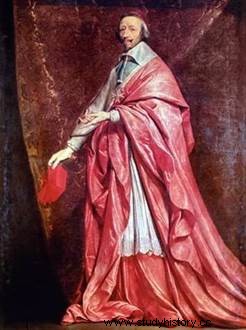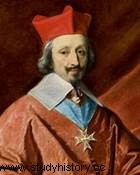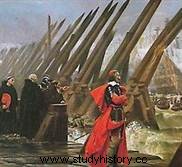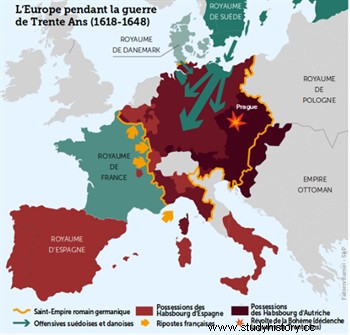 Prime Minister of Louis XIII from 1624 to 1642, Cardinal de Richelieu occupies an eminent place in the pantheon of great French statesmen. He will have presided, alongside the king with whom he will form a memorable political duo, to the great return of France on the international scene after the bloodletting of the Wars of Religion. In agreement with the sovereign, Richelieu intervened in all areas of political life, reforming finance, the army, legislation and encouraging trade. When he died in 1642, the cardinal was not very popular. Often perceived as an apostle of reason of state, he skillfully embodied the plan to strengthen the monarchical authority of the Bourbons and laid the foundations for the greatness of the kingdom of France in the Great Century.
Prime Minister of Louis XIII from 1624 to 1642, Cardinal de Richelieu occupies an eminent place in the pantheon of great French statesmen. He will have presided, alongside the king with whom he will form a memorable political duo, to the great return of France on the international scene after the bloodletting of the Wars of Religion. In agreement with the sovereign, Richelieu intervened in all areas of political life, reforming finance, the army, legislation and encouraging trade. When he died in 1642, the cardinal was not very popular. Often perceived as an apostle of reason of state, he skillfully embodied the plan to strengthen the monarchical authority of the Bourbons and laid the foundations for the greatness of the kingdom of France in the Great Century.
Richelieu, from the service of the Queen to that of the King
Armand Jean du Plessis Cardinal de Richelieu born September 9, 1585 is the fifth of six siblings. Coming from a line of noble Poitevins, he was initially destined for the profession of arms. Fatherless at the age of 5, he nevertheless enjoys a privileged position due to the gratitude of King Henry IV to his family (Armand's father having served as Grand Provost of France). Following a careful education which combines learning weapons and classical humanities, Armand did not however have the opportunity to shine in the military field. Following the refusal of one of his brothers to take charge of the bishopric of Luçon (entrusted to the Richelieus by the King), he was forced to become an ecclesiastic. Although he describes his diocese as “the dirtiest in France. the young Armand will quickly enjoy his new role.
It must be said that the new 22-year-old bishop is not lacking in talent. Intellectually brilliant, charismatic and subtle, he had the soul of a reformer committed to the theses of the Council of Trent. Richelieu also took advantage of the complicity he forged with Father Joseph (François Leclerc du Tremblay), his future gray eminence and his inspiration in many matters. Deputy of the Poitvein clergy in the Estates General of 1614 (the last before those of 1789), the handsome and ambitious prelate stood out for his oratorical talent. He particularly caught the attention of the Queen and regent Marie de Médicis, who made him her grand chaplain the following year. In 1616 Richelieu joined the King's Council as Secretary of State.
 Originally the relationship between Louis XIII and the Bishop of Luçon can only be strained. Richelieu is the liege man of the Queen Mother, from whom Louis only dreams of freeing himself. So when the young king had Concini, the Marshal of Ancre and favorite of Marie, eliminated, Armand Jean du Plessis found himself clearly rejected on the losing side. This is the beginning for him of several difficult years, where in exile in Blois with the queen or in his bishopric, he takes the time to think about his future and that of France.
Originally the relationship between Louis XIII and the Bishop of Luçon can only be strained. Richelieu is the liege man of the Queen Mother, from whom Louis only dreams of freeing himself. So when the young king had Concini, the Marshal of Ancre and favorite of Marie, eliminated, Armand Jean du Plessis found himself clearly rejected on the losing side. This is the beginning for him of several difficult years, where in exile in Blois with the queen or in his bishopric, he takes the time to think about his future and that of France.
A time beaten down by this reversal of fortune, the ambitious man will eventually pull himself together and play a leading political role. Convinced that the latent war between the King and his mother is ruining all hope of stability for the kingdom, he strives to bring the two camps closer together. A skilful diplomat, willingly a charmer, he was the craftsman of several treaties ending the "wars of mother and son" which earned him sufficient esteem to win the cardinal's hat in 1622. A living symbol of reconciliation (alas very fragile) between Marie and Louis, he returned to the King's Council in 1624, before becoming its Prime Minister a few months later.
Cardinal de Richelieu and Louis XIII
Returning to business and at the highest level, Richelieu quickly showed himself to be a convinced supporter of the strengthening of monarchical authority. Managing to dissipate the mistrust he initially inspired in the King, the cardinal shared with him the vision of a consolidated and powerful kingdom and posed as a continuation of the work of Henry IV. In doing so, Richelieu can only eventually attract the hostility of Marie de Medici, who does not share his political views. Indeed, if Louis and the cardinal both plan to ensure the religious unity of the kingdom by cutting back on the privileges acquired by the Huguenots following the wars of religion, they also intend to affirm the European position of France against the Habsburgs, who have the favors of the devout party of which the Queen is a figure. On the other hand Richelieu like Louis intend to discipline a great French nobility quick to rebellion and with whom the queen mother maintains close relations.
 In a few years, Richelieu, architect of the reconciliation between Louis and Marie, became the latter's worst enemy. During the famous "day of dupes", Louis XIII, under pressure from the devout party, pretended to give in to them before changing his mind and deciding in favor of his cardinal-minister, forcing his mother into exile. Richelieu then had his hands free to apply his “program” with vigor. ". The internal war against the Protestants supported by England was waged at full speed, giving the cardinal the opportunity to shine as a warlord as at the siege of La Rochelle. The Peace of Alès of 1629, although confirming freedom of worship, suppressed Protestant strongholds, a legacy of the Wars of Religion. This is a first questioning of the Edict of Nantes, which will gradually be emptied of its substance. It is also the affirmation of royal power, which tends to assume control of military infrastructure.
In a few years, Richelieu, architect of the reconciliation between Louis and Marie, became the latter's worst enemy. During the famous "day of dupes", Louis XIII, under pressure from the devout party, pretended to give in to them before changing his mind and deciding in favor of his cardinal-minister, forcing his mother into exile. Richelieu then had his hands free to apply his “program” with vigor. ". The internal war against the Protestants supported by England was waged at full speed, giving the cardinal the opportunity to shine as a warlord as at the siege of La Rochelle. The Peace of Alès of 1629, although confirming freedom of worship, suppressed Protestant strongholds, a legacy of the Wars of Religion. This is a first questioning of the Edict of Nantes, which will gradually be emptied of its substance. It is also the affirmation of royal power, which tends to assume control of military infrastructure.
The recovery of the kingdom
At the same time as the confrontation with the Protestants, Louis XIII and Richelieu stubbornly faced the desire for independence and the revolt of the “Grands. ". From 1626 to 1638 (date of the birth of the heir to the throne, the future Louis XIV) there were no less than half a dozen major plots, some of which involved the King's own wife:Anne of Austria and frequently leading to armed revolts. They reveal a tense context fueled by the assertion of the authority of the royal state.
Because during this period of twelve years, so many reforms for France! The cardinal and the king will rationalize and strengthen the administration, put an end to certain feudal survivals (including duels), develop the navy, trade and the colonies, supervise cultural development... A work that will be continued by another cardinal, first master of Louis XIV in politics:Mazarin. The latter also joined Richelieu's team in 1639, who saw in this diplomat in the service of the pope a possible successor.
In exercising power, Richelieu and Louis XIII proved to be complementary. Where the King shows audacity and firmness, the cardinal uses prudence and flexibility. Richelieu knew better than anyone how to put the King's wishes into practice, giving them the substance and realism necessary for their success. The two men esteem and respect each other, but until the end a certain distance will persist between them, the result of their differences in character.
Be that as it may, their association is a success amply demonstrated by France's return to the European scene. The powerful France dreamed of by the cardinal and his king could not stay away for long from the conflict that was ravaging the Holy Empire. The Thirty Years War gave France the opportunity to reduce the power of the Habsburgs that surrounded it. In foreign policy, the French are content to support the enemies of Vienna and Madrid, especially Sweden.
 In 1635 this "Cold War" ended when war broke out between France and Spain. It is a cruel and costly conflict. From their possessions of Franche-Comté, Milanese and the Netherlands (present-day Belgium and part of present-day northern France) the Spaniards were able to strike on all French borders. The Habsburg troops can count on the support of many allies and on various betrayals. The first years were therefore difficult for French arms.
In 1635 this "Cold War" ended when war broke out between France and Spain. It is a cruel and costly conflict. From their possessions of Franche-Comté, Milanese and the Netherlands (present-day Belgium and part of present-day northern France) the Spaniards were able to strike on all French borders. The Habsburg troops can count on the support of many allies and on various betrayals. The first years were therefore difficult for French arms.
The end of Richelieu's career
If the Thirty Years' War was an opportunity for Richelieu to further develop the power and resources of the state apparatus, it brought him new enmities. At the twilight of his life, although all-powerful, the cardinal was widely hated by a population he overwhelmed with taxes. With age, Richelieu, whose fragile health was then frankly declining, lost the suppleness and subtlety that had served him so well at the start of his career. "The red man" yet protector of the arts (he made the French Academy official in 1635) and enlightened prelate saw himself decked out with a reputation as a bloodthirsty tyrant. During the last months of his life, his relations became strained with a Louis XIII plagued by doubts and remorse about his war against the Catholic power that was Spain.
Carried away by lightning pleurisy, Cardinal Richelieu died on December 4, 1642. His death provoked an explosion of popular jubilation, with which the King did not publicly associate himself. King Louis XIII finally emancipated from his minister of cardinal will survive him only a few months. On his death, it is indeed the spiritual son of Richelieu who will take the reins of the kingdom alongside Queen Anne of Austria:Mazarin...
Bibliography
- Richelieu by Françoise Hildesheimer. Flammarion, 2008.
- Richelieu:The Ambitious The Revolutionary The Dictator by Philippe Erlanger. Tempus, 2006.
- Richelieu's France by Michel Carmona. Fayard, 1998.
